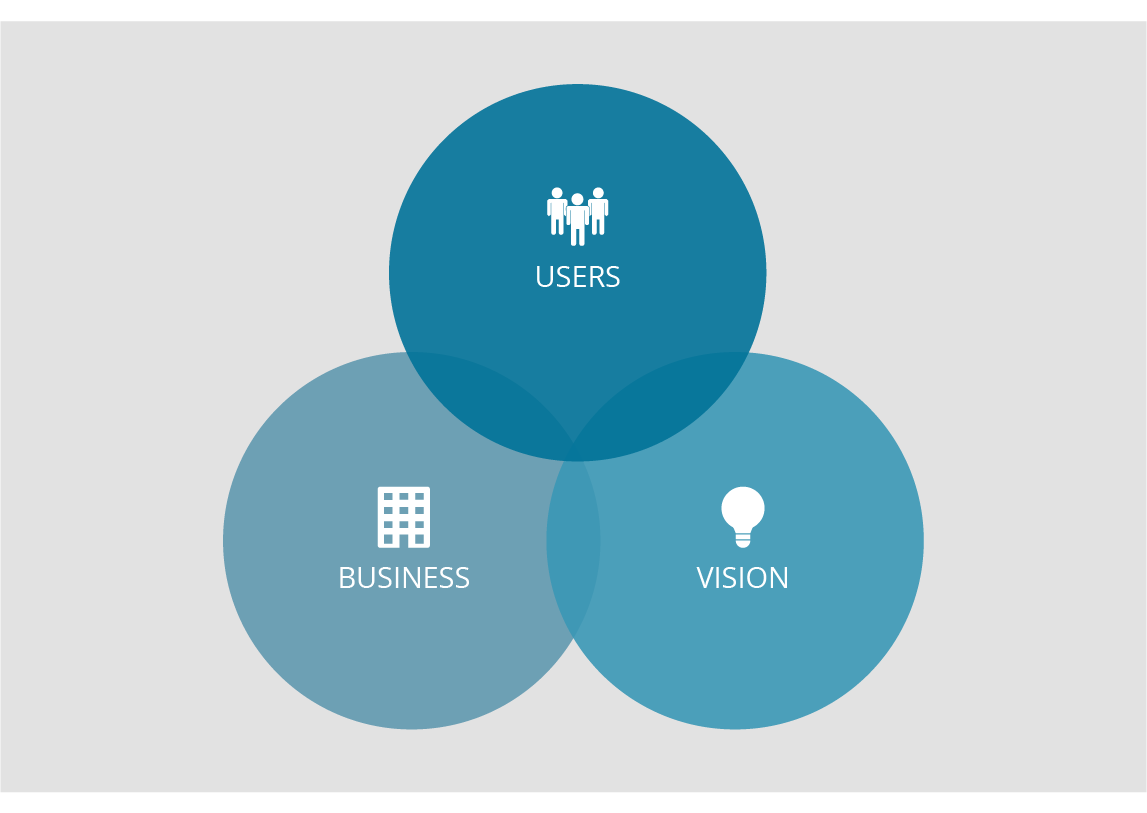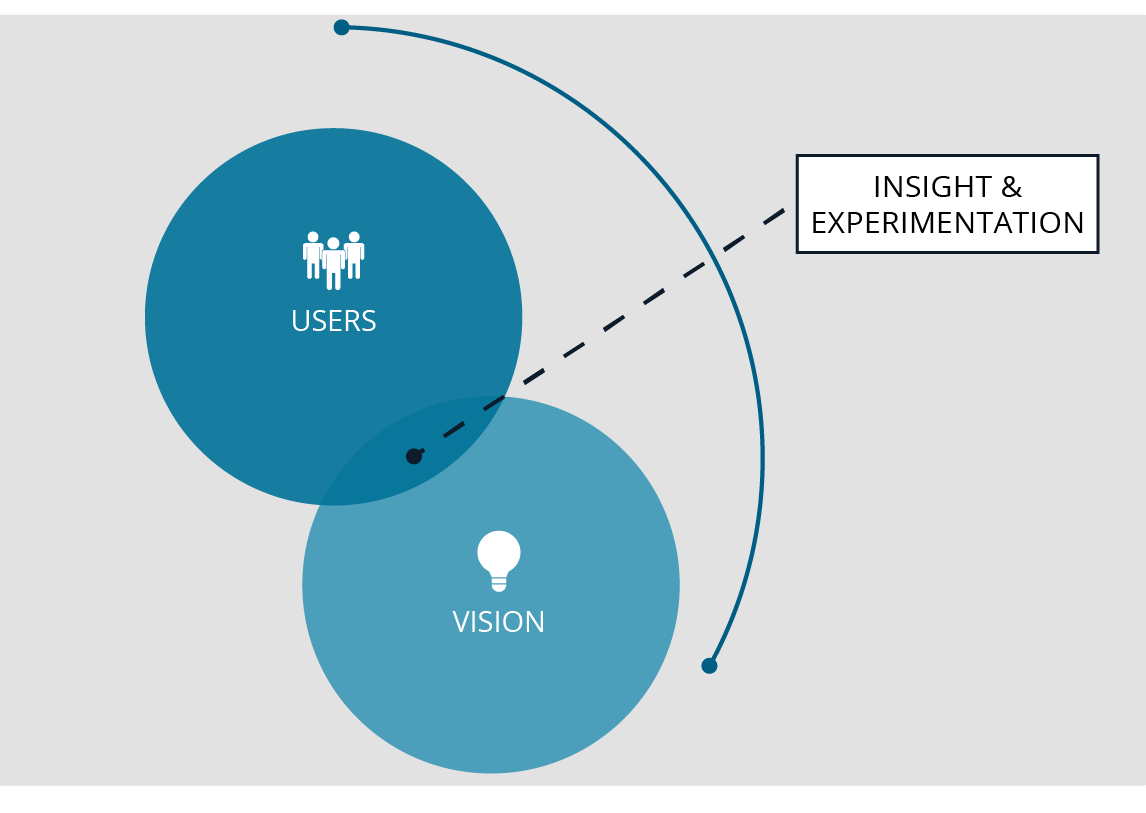For the first time in a while, I recently delivered a short, in-person talk, entitled “Lessons Learned from Becoming a Product-led Organisation.” The contents comprised an introduction into what it means to be Product-led, why we should aspire to be more Product-led, selecting a starting point and 5 key learnings from my experience of scaling a Product-led approach (a future feature, perhaps?) All this, smooshed into a whirlwind 25-minute timebox. Whew.
Despite it being the end of the day, the people in the audience were energised and engaged, asking insightful questions during the session, with a handful of humans sticking around beyond the end of the talk to explore some things in greater depth. One specific element which seemed to spark peoples’ curiosity, was this model, which I used to describe a Product-led approach. I feel, therefore, there is value in exploring it further in isolation.

I drew a rough version of this years ago when trying to succinctly explain my Product Management role to some stakeholders in a previous job, and have used it in its current, rather more polished, incarnation to support various conversations since. Let’s unpack it, shall we?
Unpacking the model: A deeper dive
The stuff in the middle

Ask most people with a Product background and they’ll confidently tell you this is clearly a Venn diagram with a sweet spot in the centre, and that’s surely where we want to be plotting our stuff if we’re going to call ourselves “Product-led”. Surely?
Well… not quite.
Think instead of the three orange circles as representing lenses, rather than categories. A lens is something we observe the world through. As we curate the long-lived things which create sustainable value through the product lifecycle, these are powerful lenses through which we may observe our organisation, and the value it creates.
Each lens offers a distinct perspective on value creation. This can help us identify imbalances – areas in which we are currently over, or under-indexing. In the real world, we know that achieving a perfect balance all of the time is neither practical, nor necessarily desirable. External factors like market conditions or industry technology shifts might lead us to consciously choose to focus more on one or two of these perspectives at a time. Similarly, internal factors, such as resource availability, capability or capacity might be driving a particular stance.
User lens
Users are at the heart of modern Product-led practice. A deep understanding of your users is the foundation for successful Product-led decision-making, hence we endeavour to involve users at every stage of the design and delivery process. This helps us to better see the challenges they’re facing, the needs they have, the behaviours they exhibit and the value our products create for them in the context of how they use them.
Business lens
The financial, structural and operational aspects of organisations are paramount to consider. After all, a business which doesn’t make money is just an expensive hobby! The business provides the resources and capabilities necessary to build, launch, maintain and improve products. In exchange, the business expects its products to realise certain benefits. The organisation also provides constraints, be they financial, capacity or capability-related, or sadly in some cases, political.
Vision lens
A Product-led approach shares many aspects with design thinking. Design is imagining the future, then creating it. We imagine the future with Vision. This does mean however that value observed through this lens is representative of a potentially valuable future state. Unfortunately, this can influence perception that the potentially valuable future state is not as important as the more tangible ‘now’ value, especially as there is usually significant investment required in developing the ‘new’ before any revenue is realised.
A compelling Vision can however be the ‘secret sauce’ which powers a Product-led organisation. Sometimes a leap of faith is required, a mountain has to be moved, and a room full of sceptics have to be convinced. When venturing into uncharted territory, clear Vision gives us direction and a means to understand if we’re getting closer or further away, helping manage the inevitable uncertainty along the way.
Balancing act: Pairs of lenses
Each lens pairs predominantly with its adjacent neighbour, which represents the constructive tension between each pair and the opposing lens. For example, in the overlap between the Business and User value perspectives, we might see a focus on short-term value from a “tell us what you want and pay us to build it” approach. This is in opposition to Visionary value where pure R&D investment might reduce capacity to service this short-term value delivery. Where the Business and Visionary value perspectives overlap, we might see value in the form of technical capability which, whilst brilliant, isn’t understood or doesn’t solve any Users’ problems. Similarly, we could see value in an innovative concept with huge user appeal where the Visionary and User perspectives overlap, but looking through the Business lens, there is no way to operationalise or monetise it.
Remember, a lens gives us a perspective, but it doesn’t change whatever it is we’re observing. If we want to do that, we need to take action or intervene. This brings us onto the stuff on the outside.
The stuff on the outside
The stuff on the outside represents the mechanisms we use to balance our different perspectives and execute with a Product-led organisational approach. If we examine our organisation through our Business, User and Vision lenses and identify that action, intervention or guidance is required, these are the levers we can pull on.
Insight & experimentation
In order to create value, we need to meet (and often exceed) users’ needs, solve their problems, make it easy for them to get their “jobs to be done,” done. To do that, we need to listen closely to what our users want.

But hang on a moment, does anyone remember the old phrase often attributed to Henry Ford, “If I had asked my customers what they wanted they would have said a faster horse.” This reminds us that we shouldn’t always listen to our users.
We need to balance our future-focus with understanding our users, and considering that only a small portion of our ideas result in an uplifted user experience, that’s easier said than done. Harnessing the power of insights (not just what is the raw data, but what does it tell us?) to understand what we don’t yet know, and use that to form useful and testable hypotheses. From these hypotheses, carefully designed experiments allow us to test and learn, helping to optimise where we do (and more importantly, don’t) invest if we are to create sustainable value.
Strategy
Strategy is the link between the ‘why’ and the ‘how’. It provides crucial guardrails for decision-making, allowing decisions to be made closer to where the work gets done, which in turn promotes autonomy and ownership. These aspects foster empowerment, allowing teams and people to operate effectively and perform with agility whilst maintaining appropriate governance and risk management.

Good strategy articulates ‘what’ problem is being solved and the high-level approach, but should be carefully crafted so as not to specify the solution. Boundaries where the organisation does not intend to compete are usually implied, but in some cases may be made explicit (a Cyber Security business may wish to specify in their strategy that they don’t compete in testing physical security measures, for instance.)
Delivery & feedback

Value can only be realised once it is used by those for whom it is intended. Delivery effectiveness, therefore, is a key determining factor in how our organisation is able to create sustainable value. Effective delivery is delivering the thing right, delivering the right thing, and delivering it fast.
Value for the organisation can be unlocked by bringing users into the delivery process. When feedback loops are shortened and coupled with continuous, iterative delivery, the resulting outputs are more likely to generate value. In order to make better, faster decisions based on deep understanding and feedback loops, many organisations are embracing systems which enable co-creation of value.
Well-designed and executed organisational ways of working and agile governance systems are necessary for alignment and risk management. Creating an environment of trust and accountability, as well as a regular cadence of continuous improvement inspecting and adapting, further adds to the robustness of the organisation’s ability to deliver sustainable value.
Bringing it all together
A Product-led organisation exhibits several key attributes in the way it is designed and runs.
We expect a Product-led organisation to be value driven – balancing user, business & visionary perspectives. Data & insight from experiments inform decision-making, and clear vision and strategy provide guardrails for decisions to be decentralised. Empowered teams deliver value continuously in iterations, adjusting and improving based on user feedback.
The User, Business and Visionary lenses help to reveal and challenge how sustainable value is created by the organisation. The supporting mechanisms of Insight & experimentation, Strategy and Delivery & feedback allow the organisation to pivot and take action to adjust and influence the balance between perspectives.
This model can be useful in evaluating how your organisation creates value from different perspectives, identifying areas which are over or under-indexed and how to influence them, and progress towards becoming more Product-led. While this article has focused on the organisational level, there is no reason why it cannot be used at product or even significant feature level depending on your role and where your organisation is on its Product-led journey.
Read my previous blog: Five tried and tested ways to build better products


